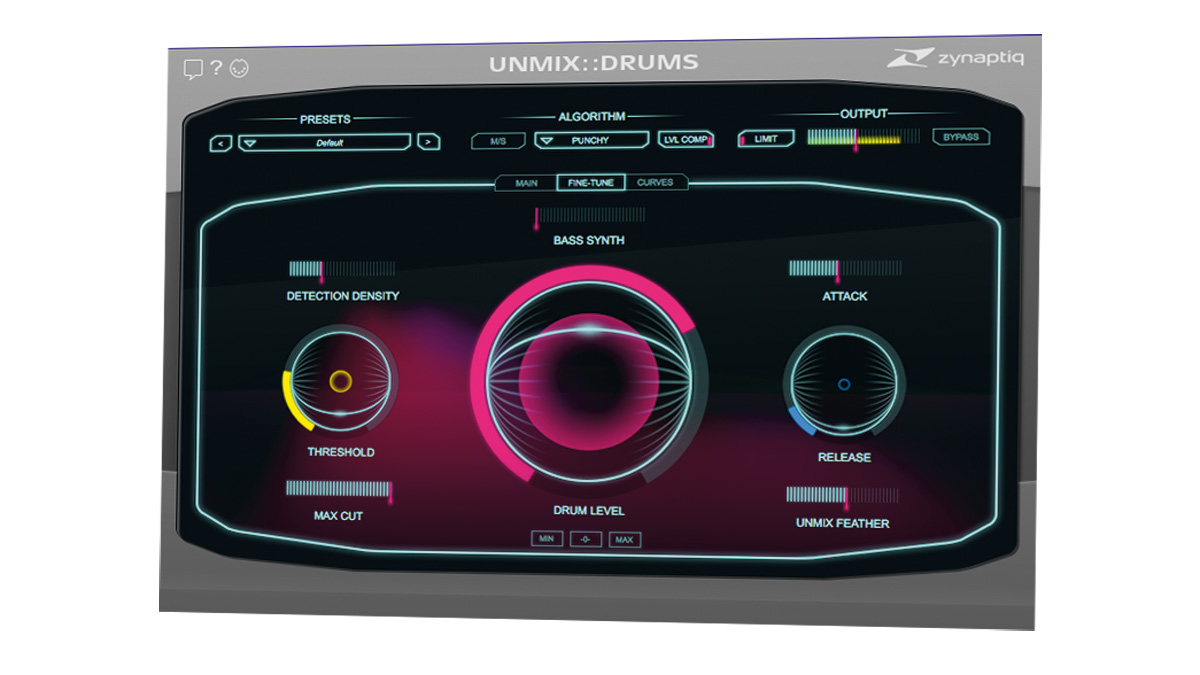MusicRadar Verdict
Another quasi-magical plugin from zynaptiq, Unmix::Drums really does give you the ability to boost and attenuate drums in a mix, collectively or individually.
Pros
- +
An original concept, well executed. Intuitive GUI. Broad range of control.
Cons
- -
M/S setting doesn't give independent mid/side control.
MusicRadar's got your back
Unmix::Drums (VST/AU/RTAS/AAX) claims to let you manipulate the level of drums in a full mix without dynamically affecting their harmonic content.
It's arranged across three pages of increasing complexity. The Main (basic) layer contains three principal controls that do the majority of the setup: Drum Level, Threshold and Release.
The Fine Tune (advanced) page repeats the basic controls and adds to them with Attack, Detection Density (the amount of threshold-exceeding signal scanned in terms of time and frequency), Mix Cut, Unmix Feathering (blurs the distinction between drum and non- drum material for a smoother result) and Bass Synth. The third page, Curves, gives frequency- dependent control of the three Main parameters.
Above the main parameter section is the Global area, where you call up presets, set the core Algorithm (Punchy or Smooth), activate Mid/Side mode, apply automatic Level Compensation (always useful when boosting drums) and control the Output level (manually, with a limiter, or both). The Mid/Side mode is a bit misleading, as it actually behaves more like a stereo balance control, preventing the stereo image skewing when drums are hard panned.
The central Drum Level control turns any drum sounds in the input signal up or down, with three buttons below setting it to the maximum, minimum or neutral. The Threshold control sets the discrimination point between drum and non-drum material.
This isn't an orthodox RMS level detection threshold but an 'intelligent' waveform detector: the higher the threshold, the more obviously drum-like the waveform has to be to be cut or boosted. As the Threshold is turned down, it starts to mistake chord hits, for example, as drums, which may or may not be desirable. To the right, the Release control sets the length of the drum tail.
The Curves page takes things to an even greater degree of precision, targeting the processing at specific drums using a graphical frequency curve editor. If the snare or clap is too loud, for example, but the kick is where you want it, you can shape the detection filter curves for the main level and threshold parameters around just the snare frequencies.
Even subtle changes to the curves bring clear results, although it's a shame we can't solo the detection circuit to hear the processed signal on its own.
There's even a built-in sub-bass synth for adding harmonic weight - handy for countering low-frequency loss that can be caused when tightening up a drum loop's envelope.
Un::believable
In action, Unmix::Drums is incredibly impressive. The three intuitive main controls combine to tune in the sound you want quickly and easily, while the Fine Tune page lets you discriminate further between drums and the rest of the mix, and shape the sound of the former.
Beyond the fact that Unmix::Drums is a great corrective tool, delivering extremely effective results, it also has huge creative potential. You can use it to bring the dynamics back into an overcompressed drum bus, or tweak the level of a kick drum within a mix, but it's also a powerful weapon for creating builds in DJ sets and injecting life into flat drum loops.
Computer Music magazine is the world’s best selling publication dedicated solely to making great music with your Mac or PC computer. Each issue it brings its lucky readers the best in cutting-edge tutorials, need-to-know, expert software reviews and even all the tools you actually need to make great music today, courtesy of our legendary CM Plugin Suite.
“Built from the same sacred stash of NOS silicon transistors and germanium diodes, giving it the soul – and snarl – of the original”: An octave-fuzz cult classic returns as Jam Pedals resurrects the Octaurus
What’s the buzz? Meet Yellowjacket, Cherry Audio's recreation of EDP’s trend-setting Wasp from 1978
“A fabulous trip through all eight songs by 24 wonderful artists and remixers... way beyond anything I could have hoped for”: Robert Smith announces new Cure remix album











